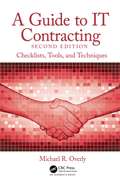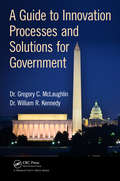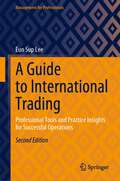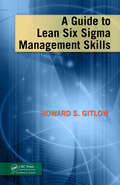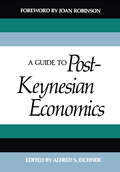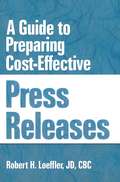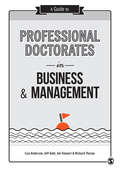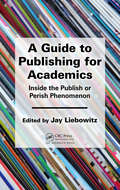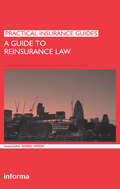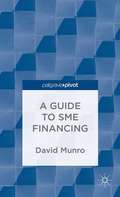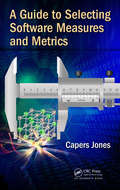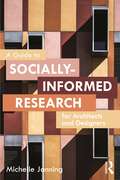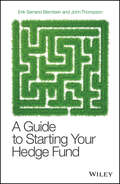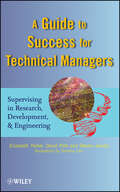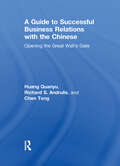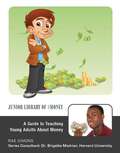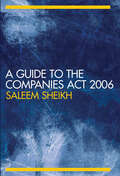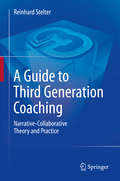- Table View
- List View
A Guide to IT Contracting: Checklists, Tools, and Techniques
by Michael R. OverlySince A Guide to IT Contracting: Checklists, Tools, and Techniques first published, several alarming trends have developed in the technology contracting industry. These trends include: The Dawn of the "As-Is" Technology Product The Ever-Changing Product Where in the World Is My Data? To meet these challenges, the Second Edition helps business managers and lawyers explore alternate solutions from other vendors, conduct simultaneous negotiations with other vendors, and, generally, ensure prospective vendors understand they can "lose the deal" if they refuse to act reasonably. Distilling the most critical business and legal lessons learned through the author’s decades of legal experience drafting and negotiating IT-related agreements, this single volume lets readers quickly access information on virtually every type of technology agreement. Structured to focus on a particular type of IT agreement, each chapter includes a checklist of essential terms, a brief summary of what the agreement is intended to do, and a complete review of the legal and business issues that are addressed in that particular agreement. Providing nonlegal professionals with the tools to address IT contracting issues, the book: Contains checklists to help readers organize key concepts for ready reference Supplies references to helpful online resources and aids for contract drafting Includes a complete glossary that defines key legal, business, and technical terms Technology contracting is becoming ever more difficult. This book is filled with recommendations to mitigate potential risk and makes clear the importance of maintaining negotiating leverage with potential vendors.
A Guide to Innovation Processes and Solutions for Government
by Gregory C. McLaughlin DBA William R. Kennedy DBAThis book provides a roadmap for successful implementation of innovation for organizations working as subcontractors or suppliers for the federal government. With a focus on the federal sector, it details tools and processes that can make significant improvements in how the federal sector handles innovation opportunities. Presenting insights that can help readers bridge the gap between supplier and customer, the book includes many examples and a case study that illustrate the application of the methodology. It also includes process flowcharts, tools, and strategies for innovation within an agency or organization.
A Guide to International Trading: Professional Tools and Practice Insights for Successful Operations (Management for Professionals)
by Eun Sup LeeThis book offers a practical guide for successful international trade operations. Written for MBA students and professionals, it provides tools and best practices for managing and operating complex international trade transactions. Readers learn about the legal, administrative, and practical aspects of international business transactions and how to gather and manage the proper information needed. The book covers topics such as public and private regulation of international trade, overseas market research, international trade terms, international trade contracts, payment collection, international transportation, marine cargo insurance, exchange rate risk, electronic commerce, and claims and dispute resolution. It is a valuable resource for both business students and professionals involved in international trade or export businesses.
A Guide to Lean Six Sigma Management Skills
by Howard S GitlowIn summary, the purpose of Six Sigma management is topromote joy in work for all employees so that they have the energy to participate in the improvement and innovation projects identified from the organizational dashboard! Authored by Dr. Howard Gitlow, one of the most respected Six Sigma Master Black Belts, this well-organized volume demonstrates the implementation of quality improvements into all areas of the workplace from the shop floor through a company‘s executive offices. Illustrating his points with a number of case studies, theauthor provides a compelling argument as to why Six Sigma should be the preferred approach. The book explains how to build an organization that encourages and values the input of quality teams detailing the steps required to implement and maintain lean initiatives.
A Guide to Marxian Political Economy: What Kind Of A Social System Is Capitalism?
by Teinosuke OtaniThis textbook offers a comprehensive guide to the systematic structure of capitalism, while at the same time introducing readers to all three volumes of Marx’s Capital. Based on his extensive expertise on Marx’s critique of political economy, the author reveals the specific structure of production in capitalist societies and explicates what sets this system apart from other modes of production. Marx’s political economy is explained in a systematic and easy-to-understand manner, using numerous illustrative diagrams to complement the text. This textbook will appeal to all students and scholars looking for a more comprehensive, systematic and theoretical explanation of capitalism, equipping them with a solid theoretical understanding of its core structure.
A Guide to Modern Economics
by Ian Stewart Michael Bleaney David GreenawayThis work provides a valuable review of the most important developments in economic theory and application over the last decade. Comprising twenty-seven specially commissioned overviews, the volume presents a comprehensive and student-friendly guide to contemporary economics.Previously published by Routledge as part of the Companion to Contemporary Economic Thought, these essays are made available here for the first time in a concise paperback edition. A Guide to Modern Economics will be a valuable guide to all those who wish to familiarize themselves with the most recent developments in the discipline.
A Guide to Post-Keynesian Economics
by Alfred S. EichnerDoes there exist an alternative to the “neoclassical synthesis” presented to students in introductory, intermediate, and advanced economics courses? The alternative is the post-Keynesian theory which is the subject of this book.
A Guide to Preparing Cost-Effective Press Releases
by William Winston Robert H LoefflerA Guide to Preparing Cost-Effective Press Releases is an instructional approach to writing and effectively using the press release. It offers suggestions and recommendations for creating basic press releases and details how the release can extend the life of an ad campaign, providing high degree publicity at low cost.In an age of great emphasis on high performance, cost effectiveness, measurable success, and fast results, this book explains how a well-developed press release program can “super charge” an advertising program. Robert Loeffler reviews the basics of press release writing, gives several examples of successful press releases, and explains in detail how the reader can set up an ongoing press release program to provide a high degree of effective publicity at very low cost. As a major form of communication for businesses, public and private institutions, and the government, the press release is a tailor-made promotional tool for both large and small budgets. Loeffler discusses the mechanics of writing press releases, providing the press release writer with:a diagrammed writing approach for clear structurea list of do's and don'ts to prevent common errorssamples of the most common types of releasesa step-by-step explanation of release production, so as not to overlook important tasks for completionsuggestions on how to write related releases, such as tradeshow press kitsExperienced in-house communications and PR writers, nonprofit PR staffs, government and military public affairs staffs, and advertising agency writers will find Loeffler's book a handy reference for polishing press release writing skills. College undergraduate classes in journalism, technical writing, and business communication will find A Guide to Preparing Cost-Effective Press Releases a useful tool in learning the fundamentals of press release writing.
A Guide to Professional Doctorates in Business and Management
by Jim Stewart Lisa Anderson Professor Richard Thorpe Jeff Gold*Shortlisted in the Management and Leadership Textbook Category at CMI Management Book of the Year Awards 2017* Lecturers, request your electronic inspection copy here. Are you undertaking (or thinking of doing) a Doctor of Business Administration (DBA) or other professional doctorate (PD) in business and management? Or perhaps you’re supervising and delivering one of these programmes? This is your complete - and practical - guide to succeeding on this course. A Guide to Professional Doctorates in Business and Management has been written by a team of experts with experience of the challenges faced in both studying for and supervising professional doctorates in business and management. Inside they address the key issues faced, in particular how these courses differ from a traditional PhD, and the different skills and approach needed for success. Chapters explore the nature and importance of PDs as leading change in the professional world of practice, and how they need to differ from traditional forms of doctorate such as PhDs. The guide also offers practical guidance on researching in this particular mode, and through writing and publishing a thesis, making a valuable contribution to professional knowledge.
A Guide to Professional Doctorates in Business and Management
by Jim Stewart Lisa Anderson Professor Richard Thorpe Jeff GoldAre you undertaking (or thinking of doing) a Doctor of Business Administration (DBA) or other professional doctorate (PD) in business and management? Or perhaps you're supervising and delivering one of these programmes? This is your complete - and practical - guide to succeeding on this course. A Guide to Professional Doctorates in Business and Management has been written by a team of experts with experience of the challenges faced in both studying for and supervising professional doctorates in business and management. Inside they address the key issues faced, in particular how these courses differ from a traditional PhD, and the different skills and approach needed for success. Chapters explore the nature and importance of PDs as leading change in the professional world of practice, and how they need to differ from traditional forms of doctorate such as PhDs. The guide also offers practical guidance on researching in this particular mode, and through writing and publishing a thesis, making a valuable contribution to professional knowledge.
A Guide to Publishing for Academics: Inside the Publish or Perish Phenomenon
by Jay LiebowitzMost academics still wrestle with the "publish or perish" phenomenon. Based on Dr. Liebowitz's 25 years serving as the editor-in-chief of a leading international journal, along with insights from some of the most knowledgeable journal editors, this book shares key lessons learned to help new professors, doctoral students, and practitioner-scholars
A Guide to Reinsurance Law (Practical Insurance Guides)
by Robert MerkinThis practical guide offers a useful introduction to reinsurance, taking you step by step through the associated issues you really need to know about. An introduction is provided, setting the scene for further chapters on key topics such as the formation of agreements, terms, rights and obligations. The book covers the following areas: Nature of Reinsurance, Formation of Reinsurance, Agreements, Utmost Good Faith, Terms of Reinsurance Agreements, Rights and Obligations of the Parties, Follow the Settlements and Follow the Fortunes, Claims, Intermediaries, Jurisdiction and Applicable Law, Arbitration.
A Guide to Research Methodology: An Overview of Research Problems, Tasks and Methods
by Shyama Prasad MukherjeeResearch Methodology is meant to provide a broad guideline to facilitate and steer the whole of a research activity in any discipline. With the ambit and amount of research increasing by the day, the need for Research Methodology is being widely appreciated. Against this backdrop, we notice the dearth of well-written books on the subject. A Guide to Research Methodology attempts a balance between the generic approach to research in any domain and the wide array of research methods which are to be used in carrying out different tasks in any research. Discussions on these research methods appropriate in various disciplines have focused on the research tasks, keeping in mind the fact that a single such task like a comparison among alternatives may involve several methods from seemingly distinct areas. Unique features of this volume, as will be evident to a discerning reader, include: A detailed discussion on problem areas for research in several domains An illustrative and ampliated list of research problems drawn from different disciplines which can be pursued by interested research workers A comprehensive delineation of Research Design supported by illustrations An elaborate engagement with models with a note on model uncertainty Focus on recent and emerging models, methods and techniques A novel treatment of data analysis where the nature of data and the objective(s) of analysis justify drawing upon a variety of techniques for analysis This book will serve the purpose of a pre-PhD or a Master-level course-work for students of any discipline with a basic knowledge of quantitative analysis. In fact, anyone aspiring to take up meaningful research work will find the content useful and interesting.
A Guide to SME Financing
by David MunroA Guide to SME Finance is a brief guide to designing and implementing a SME finance program within a commercial bank or other financial institution, such as an NGO.
A Guide to Selecting Software Measures and Metrics
by Capers JonesGoing where no book on software measurement and metrics has previously gone, this critique thoroughly examines a number of bad measurement practices, hazardous metrics, and huge gaps and omissions in the software literature that neglect important topics in measurement. The book covers the major gaps and omissions that need to be filled if data about software development is to be useful for comparisons or estimating future projects. Among the more serious gaps are leaks in reporting about software development efforts that, if not corrected, can distort data and make benchmarks almost useless and possibly even harmful. One of the most common leaks is that of unpaid overtime. Software is a very labor-intensive occupation, and many practitioners work very long hours. However, few companies actually record unpaid overtime. This means that software effort is underreported by around 15%, which is too large a value to ignore. Other sources of leaks include the work of part-time specialists who come and go as needed. There are dozens of these specialists, and their combined effort can top 45% of total software effort on large projects. The book helps software project managers and developers uncover errors in measurements so they can develop meaningful benchmarks to estimate software development efforts. It examines variations in a number of areas that include: Programming languages Development methodology Software reuse Functional and nonfunctional requirements Industry type Team size and experience Filled with tables and charts, this book is a starting point for making measurements that reflect current software development practices and realities to arrive at meaningful benchmarks to guide successful software projects.
A Guide to Socially-Informed Research for Architects and Designers
by Michelle JanningThis book offers an efficient set of step-by-step tips and overarching lessons about how to gather useful, meaningful, and socially-informed data about clients’ and other stakeholders' experiences in architecture and interior design professions. In this guide, author Michelle Janning helps the design professional conduct ongoing evaluation of design projects, create useful pre- and post-design evaluations, frame effective questions for improved future design, involve various stakeholders in the research process, and focus on responsible and evidence-based human-centered design to improve the relationship between design and people’s experiences. Examining a variety of both large- and small-scale project examples from different institutional realms, including healthcare sites, schools, residences, eating establishments, museums, and theaters, this book highlights not only the overlap in these types of projects but also the differences between project sizes that may impact the methods used in any given project. It also offers tools for how to communicate design success to audiences that include potential clients, occupants, and other designers. A Guide to Socially-Informed Research for Architects and Designers is a go-to reference for design professionals interested in using accessible social scientific methods to gather essential and practical information from people who occupy the spaces they design and to do so in an ethical, inclusive, and socially-informed way in order to enhance social sustainability in the built environment.
A Guide to Sources of Information on the National Labor Relations Board (Research and Information Guides in Business, Industry and Economic Institutions)
by Gordon T. Law M. P. CatherwoodA concise history of the board in the U.S. from its inception in 1935, including an overview of current case law, and a bibliographic essay of selected secondary literature about the board.
A Guide to Starting Your Hedge Fund
by John Thompson Erik Serrano BerntsenSuccessful hedge fund investing begins with well-informed strategy A Guide to Starting Your Hedge Fund is a practical, definitive "how-to" guide, designed to help managers design and launch their own funds, and to help investors select and diligence new funds. The first book to examine the practical aspects of setting up and operating funds with a focus on energy commodity markets, this book scrutinises the due diligence process and comprehensively reviews the opportunities and risks of all energy commodity markets as hedge fund investments. Extensive planning and strategy advice prove invaluable to prospective fund managers and investors alike, and detailed discussion of the markets' constraints help inform procedural decisions. Readers gain insight into practical matters including legal and commercial structures, due diligence, fund raising, operations, and more, allowing them to construct a concrete investment plan before ever touching a penny. Asset managers are looking to energy commodities to provide attractive uncorrelated - if volatile - returns. These high returns, however, are accompanied by high risk. Few investors have experience evaluating these investment opportunities, and few prospective fund managers understand the market fundamentals and their associated risks. This book provides the answers sorely lacking in hedge fund literature, giving investors and fund managers the background they need to make smarter decisions. Understand the markets' structures, opportunities, and risks Develop a comprehensive, well-informed investment strategy Conduct thorough due diligence with a detailed plan Examine the practical aspects of fund raising, legal and tax structure, and more Oil has long been traded by hedge funds, but electricity, the fuels that generate electricity, and the environmental products like emissions allowances and weather derivatives have become the new "hot" investment strategies. These high returns come with higher risk, but A Guide to Starting Your Hedge Fund ensures participants have essential information at their disposal.
A Guide to Success for Technical Managers
by Elizabeth Treher Timothy Carr Steven Jacobs David PiltzSupervisory Skills for the Technical Manager: A Guide to Success focuses exclusively on the dynamics of being a technical manager such as a scientist, programmer, or engineer. An R&D environment demands modified management techniques and this book explores how to do so. Drawing of years of experience to provide technical managers with various tools and ways to apply them in supervisory situation, this essential title includes exercises, templates and checklists to accelerate their uses and applications on the job. In addition, case studies are included throughout to thoroughly explain and explore the concepts discussed.Key topics include handing the transition to supervising others in research and development, the characteristics needed to motivate personnel in a R&D environment as compared to other areas of business are detailed. The pitfalls and challenges of managing technical personnel, how delegating can build an effective team that can produce superior results, and how to monitor the work of previously independent personnel are also discussed.
A Guide to Successful Business Relations With the Chinese: Opening the Great Wall's Gate
by Huang Quanyu Chen Tong Richard S AndrulisIntroduces and analyzes the Chinese people, their ideas, behavior, and cultural roots. It not only provides a sufficient theoretical basis for understanding this population, but also focuses on the various vivid practical experiences of everyday and business life. A Guide to Successful Business Relations With the Chinese alters Western business people’s perception of the Chinese people and improves their ability and skill in creating harmonious relationships with Chinese managers, colleagues, and subordinates on business and personal levels.
A Guide to Sustainable Corporate Responsibility: From Theory to Action
by Caroline D. Ditlev-SimonsenThis open access book discusses the challenges and opportunities faced by companies in an age that increasingly values sustainability and demands corporate responsibility. Beginning with the historical development of corporate responsibility, this book moves from academic theory to practical application. It points to ways in which companies can successfully manage their transition to a more responsible, sustainable way of doing business, common mistakes to avoid and how the UN Sustainable Development Goals are integral to any sustainability transformation. Practical cases illustrate key points. Drawing on thirty years of sustainability research and extensive corporate experience, the author provides tools such as a Step-by-Step strategic guide on integrating sustainability in collaboration with stakeholders including employees, customers, suppliers and investors. The book is particularly relevant for SMEs and companies operating in emerging markets. From a broader perspective, the value of externalities, full cost pricing, alternative economic theories and circular economy are also addressed.
A Guide to Teaching Young Adults About Money
by Rae SimonsParents and teachers can help young people understand the complex world of money and finance--and give them a head start in establishing good financial habits. This guide offers parents and educators resources and discussion topics for materials covered in The Junior Library of Money.
A Guide to The Companies Act 2006
by Saleem SheikhAn easy to use guide to the Companies Act 2006 and packed full of helpful features, this book provides detailed commentary on the new Companies Act. Offering a chapter by chapter analysis of the legal and practical implications of the Act, the author traces the background to the act, considering the various Consultation Documents and White Papers issued by the Government, the proposals for company law reform and their culmination in the Company Law Reform Act. It contains: helpful checklists for the busy practitioner section by section commentary useful appendices of materials and extracts on an accompanying Companion Website. This is an invaluable and handy resource for undergraduate students and practitioners studying or working in business and company law.
A Guide to The Uncitral Arbitration Rules
by Christopher Kee Clyde Croft Christopher Kee Jeffrey Waincymer Clyde CroftThe first version of the UNCITRAL Arbitration Rules was endorsed by the General Assembly of the United Nations in December 1976. Now considered one of UNCITRAL's greatest successes, the rules have had an extraordinary impact on international arbitration as both instruments in their own right and as guides for others. The Iran-US Claims Tribunal, for example, employs a barely modified version of the rules for all claims, and many multilateral and bilateral foreign investment treaties adopt the UNCITRAL Rules as an arbitral procedure. The Rules are so pervasive and the consequences of the new version potentially so significant that they cannot be ignored. This commentary on the Rules brings the official documents together in one volume and includes the insights and experiences of the Working Group that are not included in the official reports.
A Guide to Third Generation Coaching: Narrative-Collaborative Theory and Practice
by Reinhard StelterThis book proposes third generation coaching in a form where the coach and the coaches are less concerned with solutions and more concerned with creating space for (self-)reflection through collaborative practices. Offering a revisited and innovative approach to coaching psychology, advantageous for learners and practitioners alike. It marks a new trend in coaching and has a special profile, based on the acknowledgement of changes in society, learning and knowledge production, as well as leadership. The author' s concept of coaching distinguishes itself from the existing models (pop coaching , GROW model, etc) by offering a fresh analysis of our society - a society that is characterised by diversification, identity challenges, abolition of the monopoly of knowledge, lifelong learning, the necessity for self-reflection, etc. These societal changes are the basis for the existence of coaching and its prevalence, but they must also be the foundation for the way we employ coaching.
